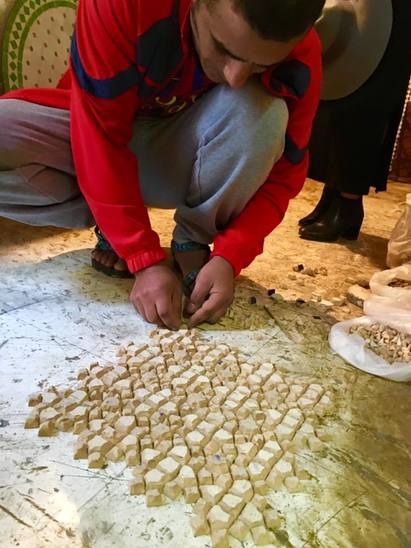|
One of the most striking features of the Moroccan architecture is the Zellij, the creation of intricate mosaic design using hand-cut tiles. Moroccan Zellij is distinguished by an extraordinary color palette and by a complex mathematical geometry. It is realized in glazed clay tiles cut into tiny individual shapes. The whole process is like a combination of abstract art and a jigsaw puzzle. As an art form it requires tremendous memory skills and a finely honed sense of order, but it also needs an artist’s eye.
This technique is of considerable antiquity and starts in the 10th Century in North Africa and Andalusia. They came into general use in Spain and the Maghrib in the first half of the 14th century. This distinctive art form reached its peak in Morocco during the rule of the Merinid dynasty of the 14th-15th centuries. Crusading Christians eventually brought an end to this Islamic splendor in Spain, but the artisans retreated to Morocco where they continued their craft.
The Spaniards still use the same patterns that one finds today in Morocco, but, unlike the Moroccans, they no longer make them by mosaic techniques. Rather, they are printed and baked on large tiles. The Moroccan Zellij maker starts, as his forefathers did, with a square glazed clay tile of rather soft texture. The tiles are about 10 cm square. Lines are drawn on the glazed side and the artisan breaks it into pieces along these lines, using a small hammer-adze. There is a variety of conventional shapes and sizes. They are put together to form geometrical patterns of great complexity.
Each piece in the mosaic has a different name, describing either its shape or its function: pointed stars or seals, cross, palm, almond, short neck, basket, knot, fork, candle… etc.
The colors are limited and simple: blue, green, white, yellow, brown and black. Red is a relatively recent addition to the color spectrum, as are the lighter and darker shades of all the aforementioned colors.
It is impossible to convey the complexity, intricacy and depth of spatial configuration in the art of Zellij. Interestingly, While there has undoubtedly been some modification in design and techniques over centuries, this craft is essentially as it was in the 14th century.
9 Comments
|
Abdul AISSAOUIMarrakesh Tour Guide Archives
January 2017
Travel & Culture
All
|
HoursM-S: 7am - 9pm
|
telephone+212 6 13 15 36 37
|
|





 RSS Feed
RSS Feed


